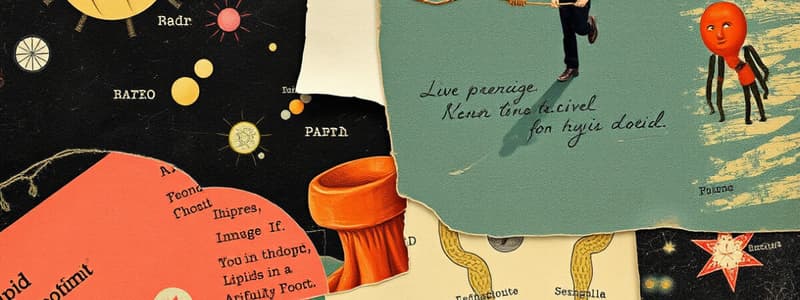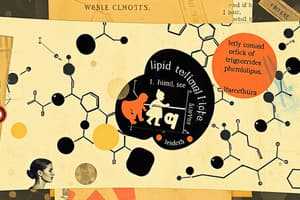Podcast
Questions and Answers
What do all lipids have in common?
What do all lipids have in common?
All lipids are nonpolar and hydrophobic, thus all lipids are insoluble in water and are linked by nonpolar covalent bonds.
What elements make up lipids?
What elements make up lipids?
Carbon, hydrogen, and oxygen
What are the four major groups of lipids?
What are the four major groups of lipids?
Fats or triglycerides, phospholipids, steroids, and waxes
What are the functions of fats?
What are the functions of fats?
What two molecules are lipids made from?
What two molecules are lipids made from?
What is the structure of glycerol?
What is the structure of glycerol?
What is a hydrocarbon chain?
What is a hydrocarbon chain?
What type of bond forms between carbon and hydrogen?
What type of bond forms between carbon and hydrogen?
What is the structure of a fatty acid?
What is the structure of a fatty acid?
To make a fat, what must combine together?
To make a fat, what must combine together?
What is a fatty acid with no double bond called?
What is a fatty acid with no double bond called?
What is a fatty acid with one or more double bonds called?
What is a fatty acid with one or more double bonds called?
What are the characteristics of unsaturated fatty acids?
What are the characteristics of unsaturated fatty acids?
What are the characteristics of saturated fatty acids?
What are the characteristics of saturated fatty acids?
What is the difference between mono and polyunsaturated?
What is the difference between mono and polyunsaturated?
What is the major component of cell membranes?
What is the major component of cell membranes?
What are phospholipids?
What are phospholipids?
What are steroids?
What are steroids?
Is cholesterol a component of animal cell membranes?
Is cholesterol a component of animal cell membranes?
Is cholesterol a component of plant cell membranes?
Is cholesterol a component of plant cell membranes?
What type of hormone is made from steroid lipids?
What type of hormone is made from steroid lipids?
What is the most hydrophobic lipid that serves as a waxy coat to prevent drying out?
What is the most hydrophobic lipid that serves as a waxy coat to prevent drying out?
Flashcards are hidden until you start studying
Study Notes
Lipid Characteristics
- All lipids are nonpolar and hydrophobic, making them insoluble in water.
- Lipids are linked by nonpolar covalent bonds.
Composition of Lipids
- Lipids consist of carbon, hydrogen, and oxygen.
Major Groups of Lipids
- Four main categories include:
- Fats (triglycerides)
- Phospholipids
- Steroids
- Waxes
Functions of Fats
- Provide long-term energy storage.
- Act as insulation (e.g., blubber).
- Offer cushioning for the body.
Building Blocks of Lipids
- Composed of glycerol and fatty acids.
Glycerol Structure
- Structure is a three-carbon chain with hydroxyl groups and hydrogen atoms.
Hydrocarbon Chain
- Formed by a chain of carbon atoms with hydrogen atoms attached.
Bonding in Lipids
- Carbon and hydrogen form nonpolar bonds due to equal electronegativity, contributing to hydrophobicity.
Fatty Acid Structure
- Consists of a hydrocarbon chain typically with around 15 carbons and a carboxyl group at one end.
Formation of Fats
- Fats are created when three fatty acids link to one glycerol through dehydration synthesis.
Types of Fatty Acids
- Saturated fatty acids:
- No double bonds, maximum hydrogen atoms, solid at room temperature, often from animals (e.g., butter, lard).
- Unsaturated fatty acids:
- Contain one or more double bonds, liquid at room temperature, primarily sourced from plants (e.g., vegetable oil), healthier option.
Mono vs. Polyunsaturated Fatty Acids
- Monounsaturated: one double bond between carbons, considered the healthiest.
- Polyunsaturated: more than one double bond between carbons.
Phospholipids
- Major components of cell membranes, composed of two fatty acids linked to glycerol, with a phosphate group attached.
- Have a dual nature; the phosphate group (polar, hydrophilic) and fatty acids (nonpolar, hydrophobic).
Steroids
- Characterized by a carbon skeleton that forms four fused rings, consisting of three six-sided rings and one five-sided ring.
- Cholesterol serves as the precursor for all steroids.
Cholesterol and Cell Membranes
- Cholesterol is found in animal cell membranes but not in plant cell membranes.
Steroid Hormones
- Sex hormones are synthesized from steroid lipids.
Waxes
- The most hydrophobic lipid, providing a waxy coat to prevent organisms from drying out.
Studying That Suits You
Use AI to generate personalized quizzes and flashcards to suit your learning preferences.




